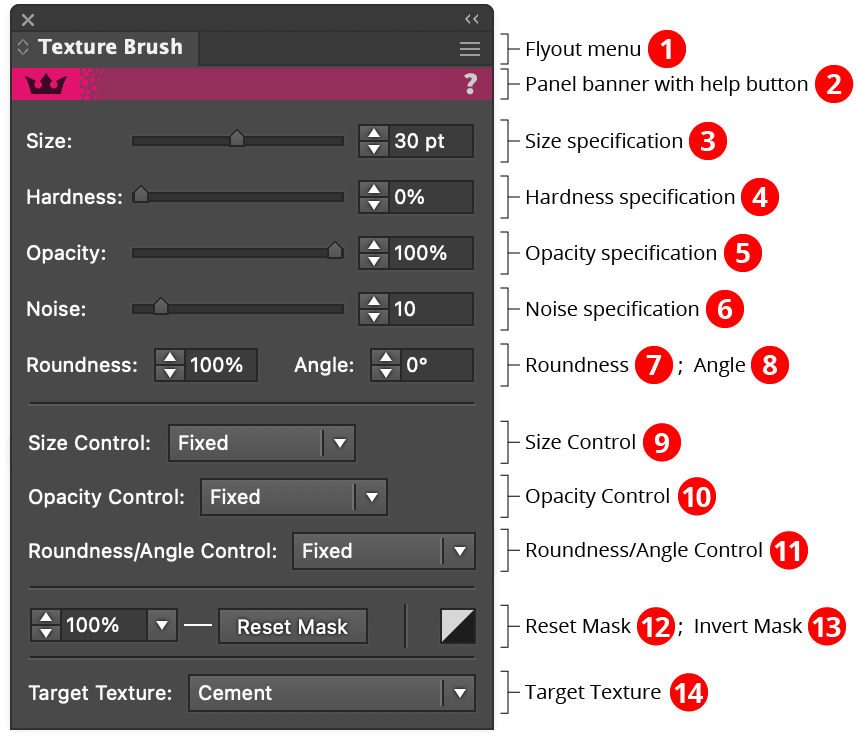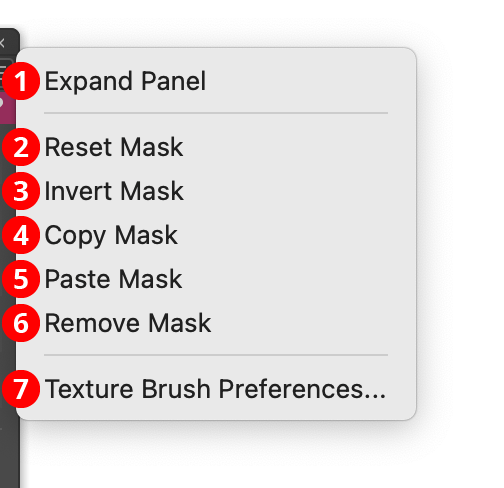 Texture Brush Panel
Texture Brush Panel
The menu item to show and hide the Texture Brush panel can be found in the main menu under Window > Astute Graphics > Texture Brush.

Texture Brush Panel
1. Flyout menu
See Texture Brush Panel: Flyout Menu.
2. Panel banner
The help button on the right opens the help documentation in the Astute Manager. If this does not automatically appear, please ensure your Astute Manager is running first.
Click on the other area of the color bar to activate the Texture Brush tool. This is a quick method of locating the tool within the default Advanced toolbar or a custom toolbar.
3. Size Specification
The size (diameter) of the brush, from 1pt to 1000pt.
4. Hardness Specification
The hardness of the brush, from 0% to 100%.
5. Opacity Specification
The opacity of the brush, from 0% to 100%.
6. Noise Specification
The amount of noise in the brush, from 0 (no noise) to 100 (maximum noise).
7. Roundness
The roundness of the brush, from 10% (highly elliptical) to 100% (circular).
8. Angle
When the brush is not at 100% roundness, the angle of the major axis of its elliptical shape.
9. Size Control
Visible when the panel is expanded. When using a mouse as the input device, it should be set to Fixed; otherwise, enables the brush size to be controlled by either the pressure or wheel setting of a stylus-like device.
10. Opacity Control
Visible when the panel is expanded. When using a mouse as the input device, it should be set to Fixed; otherwise, enables the brush opacity to be controlled by either the pressure or wheel setting of a stylus-like device.
11. Roundness/Angle Control
Visible when the panel is expanded. When using a mouse as the input device, it should be set to Fixed; otherwise, enables the brush opacity to be controlled by either the tilt/bearing or tilt/rotation setting of a stylus-like device.
12. Reset Mask
Visible when the panel is expanded. The value input specifies the base opacity of the entire mask when it is reset (or first created, if the tool preference Base Opacity Applies to New Masks is enabled), with a default of 100%. The Reset Mask button resets the mask, removing all existing brush strokes that may have been made to it and filling it with the base opacity specified in the value input box.
13. Invert Mask
Visible when the panel is expanded; inverts the texture opacity mask.

Texture Brush Panel Invert Mask
14. Target Texture
When multiple textures exist in the selected art object, or multiple objects are selected, the Target Texture menu controls which texture’s masks will be affected (each texture has its own independent opacity mask). By setting the popup menu to All Visible, all tool and panel operations (brushing, resetting, and inverting the mask) will be applied to the mask of every visible texture. Otherwise, these operations will be applied only to the specific texture chosen in the menu (if a single object is selected) or to the topmost visible textures (if multiple objects are selected).
Texture Brush Panel Flyout Menu

Texture Brush Panel Flyout Menu
1. Expand/Compact Panel
When expanded, the panel shows the size control, opacity control, roundness/angle control, reset mask area, and invert mask button.
2. Reset Mask
Resets the texture mask(s), just as clicking the Reset Mask button on the panel would.
3. Invert Mask
Inverts the texture mask(s), just as clicking the Invert Mask button on the panel would.
4. Copy Mask
Copies the texture mask to an internal clipboard. If multiple masks are selected, only the topmost mask is copied.
5. Paste Mask
Replaces the currently selected mask(s) with the texture mask that is in the internal clipboard. If the mask in the clipboard has different dimensions than a current mask, it is stretched to fit.
6. Remove Mask
Removes the currently selected mask(s), thereby restoring any selected Texture live effects to the state they had before they were brushed or had a mask pasted in.
7. Texture Brush Preferences...
Brings up the Preferences dialog (see Texture Brush: Preferences).
